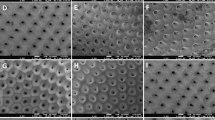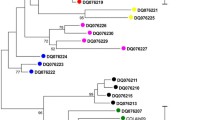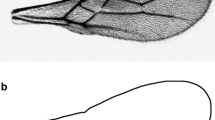Abstract
Ochlerotatus triseriatus is the natural vector of La Crosse virus, a common cause of pediatric encephalitis in the United States; the closely related Ochlerotatus hendersoni transmits this virus at low frequency. Adults of these mosquito species are difficult to distinguish morphologically; however, the larval stages show species-specific differences in several characters. We identified genomic regions contributing to the differences between the larvae of these species through interspecific hybridizations. Quantitative trait loci (QTL) were identified by standard interval mapping techniques and by univariate marker association analyses. We examined 159 F2 progeny from an Oc. hendersoni female by Oc. triseriatus male interspecific cross for variation in the number of saddle and siphon hair branches, attachment of the acus, and morphology of the anal papillae. At least one putative QTL was identified for each of the phenotypes examined. QTL most commonly mapped to linkage group (LG) III, although QTL were identified on LGI and LGII for three phenotypes each. Several of these QTL, and particularly those on LGIII, also map to genome regions controlling adult female body size and ability to orally transmit La Crosse virus. Further studies are required to elucidate the relationships among these traits and the impact they may have had on the ecological specialization and speciation of these mosquitoes.
Similar content being viewed by others
Abbreviations
- API:
-
anal papillae index
- CL:
-
confidence limits
- D/V:
-
dorsal-to-ventral gill ratio
- IM:
-
interval mapping
- LG:
-
linkage group
- LR:
-
likelihood ratio
- OR:
-
odds ratio
- QTL:
-
quantitative trait loci
- SNP:
-
single nucleotide polymorphism
References
J.A. Anderson J.R. Schneider P.R. Grimstad D.W. Severson (2005) ArticleTitleQuantitative genetics of body size and vector competence for La Crosse virus in Ochlerotatus hendersoni and Ochlerotatus triseriatus interspecific hybrids Genetics 169 1529–1539 Occurrence Handle15654112 Occurrence Handle1:CAS:528:DC%2BD2MXktFGjsbs%3D Occurrence Handle10.1534/genetics.104.033639
K.A. Angelon J.W. Petranka (2002) ArticleTitleChemicals of predatory mosquitofish (Gambusia affinis) influence selection of oviposition site by Culex mosquitoes J. Chem. Ecol. 28 797–806 Occurrence Handle12035927 Occurrence Handle1:CAS:528:DC%2BD38XjslSrsrk%3D Occurrence Handle10.1023/A:1015292827514
C.J. Basten B.S. Weir Z.B. Zeng (2001) QTL Cartographer: A Reference Manual and Tutorial for QTL Mapping. Program in Statistical Genetics Bioinformatics Research Center, Department of Statistics North Carolina State University
L. Blaustein M. Kiflawi A. Eitam M. Mangel J.E. Cohen (2004) ArticleTitleOviposition habitat selection in response to risk of predation in temporary pools: mode of detection and consistency across experimental venue Oecologia 138 300–305 Occurrence Handle14648191 Occurrence Handle10.1007/s00442-003-1398-x
L. Bullini M. Coluzzi (1978) ArticleTitleApplied and theoretical significance of electrophoretic studies in mosquitoes (Diptera: Culicidae) Parassitologia 20 7–21 Occurrence Handle1:CAS:528:DyaL3cXks1Kls7g%3D
H.W. Cai H. Morishima (2002) ArticleTitleQTL clusters reflect character associations in wild and cultivated rice Theor. Appl. Genet. 104 1217–1228 Occurrence Handle12582574 Occurrence Handle1:CAS:528:DC%2BD38XmtlWrtbY%3D Occurrence Handle10.1007/s00122-001-0819-7
Centers for Disease Control and Prevention, 2005. http://www.cdc.gov/ncidod/dvbid/arbor/lacfact.htm
E.W. Chambers D.D. Lovin D.W. Severson (2003) ArticleTitleUtility of comparative anchor-tagged sequences as physical anchors for comparative genome analysis among the Culicidae Am. J. Trop. Med. Hyg. 69 98–104 Occurrence Handle12932106 Occurrence Handle1:CAS:528:DC%2BD3sXmvFyht7g%3D
J.M. Cheveud T.H. Ehrich T.T. Vaughn S.F. Koreishi R.B. Linsey L.S. Pletscher (2004) ArticleTitlePleiotropic effects on mandibular morphology II: differential epistasis and genetic variation in morphological intergration J. Exp. Zoolog. B Mol. Dev. Evol. 302 424–435 Occurrence Handle10.1002/jez.b.21008
G.A. Churchill R.W. Doerge (1994) ArticleTitleEmpirical threshold values for quantitative trait mapping Genetics 138 963–971 Occurrence Handle7851788 Occurrence Handle1:STN:280:ByqC2MvntFw%3D
J.K. Conner (2002) ArticleTitleGenetic mechanisms of floral trait correlations in a natural population Nature 420 407–410 Occurrence Handle12459781 Occurrence Handle1:CAS:528:DC%2BD38XptFCisr0%3D Occurrence Handle10.1038/nature01105
R.S. Copeland G.B. Craig SuffixJr. (1990) ArticleTitleHabitat segregation among treehole mosquitoes (Diptera: Culicidae) in the Great Lakes region of the United States Ann. Entomol. Soc. Am. 83 1063–1073
R.S. Copeland G.B. Craig SuffixJr. (1992a) ArticleTitleDifferential oviposition by Aedes hendersoni and Aedes triseriatus (Diptera: Culicidae) in response to chemical cues associated with trechole water J. Med. Entomol. 29 33–36 Occurrence Handle1:STN:280:By2B3czislY%3D
R.S. Copeland G.B. Craig SuffixJr. (1992b ) ArticleTitleInterspecific competition, parasitism, and predation affect development of Aedes hendersoni and A. triseriatus (Diptera: Culicidae) in artificial treeholes Ann. Entomol. Soc. Am. 85 154–163
R.W. Doerge (2002) ArticleTitleMapping and analysis of quantitative trait loci in experimental populations Nat. Rev. Genet. 3 43–52 Occurrence Handle11823790 Occurrence Handle1:CAS:528:DC%2BD38XhsV2gsbY%3D Occurrence Handle10.1038/nrg703
R.E. Fulton M.L. Salasek N.M. DuTeau W.C. Black IV (2001) ArticleTitleSSCP analysis of cDNA markers provides a dense linkage map of the Aedes aegypti genome Genetics 158 715–726 Occurrence Handle11404335 Occurrence Handle1:CAS:528:DC%2BD3MXltFSisLw%3D
D.H. Graham J.L. Holmes B.J. Beaty W.C. Black IV (2003) ArticleTitleLinkage mapping of quantitative trait loci conditioning transovarial transmission of La Crosse virus in the eastern treehole mosquito, Ochlerotatus triseriatus Insect Mol. Biol. 12 IssueID4 307–318 Occurrence Handle12864911 Occurrence Handle1:CAS:528:DC%2BD3sXmt1SrsLc%3D Occurrence Handle10.1046/j.1365-2583.2003.00412.x
J.K. Grenier S.B. Carroll (2000) ArticleTitleFunctional evolution of the Ultrabithorax protein Proc. Nat. Acad. Sci. USA 97 704–709 Occurrence Handle10639143 Occurrence Handle1:CAS:528:DC%2BD3cXot1ahug%3D%3D Occurrence Handle10.1073/pnas.97.2.704
P.R. Grimstad C.E. Garry G.R. DeFoliart (1974) ArticleTitle Aedes hendersoni and Aedes triseriatus (Diptera: Culicidae) in Wisconsin: Characterization of larvae, larval hybrids, and comparison of adult and hybrid mesoscutal patterns Ann. Entomol. Soc. Am. 67 795–804
P.R. Grimstad S.L. Paulson G.B. Craig SuffixJr. (1985. ) ArticleTitleVector competence of Aedes hendersoni (Diptera: Culicidae) for La Crosse virus and evidence of a salivary-gland escape barrier. J. Med. Entomol. 22 447–453 Occurrence Handle4045939
D.J. Hawthorne S. Via (2001) ArticleTitleGenetic linkage of ecological specialization and reproductive isolation in pea aphids Nature 412 904–907 Occurrence Handle11528477 Occurrence Handle1:STN:280:DC%2BD3Mvos1Witw%3D%3D Occurrence Handle10.1038/35091062
G.H.E Hopkins (1952) Mosquitoes of the Ethiopian Region. Part I. Larval Bionomics of Mosquitoes and Taxonomy of Culicine Larvae Adlard and Son London
R.L. Kitching (1971) ArticleTitleAn ecological study of water-filled tree holes and their position in the woodland ecosystem J. Anim. Ecol. 40 281–302 Occurrence Handle10.2307/3247
H.J. Koch (1938) ArticleTitleThe absorption of chloride ions by the anal papillae of diptera larvae J. Exp. Biol. 15 152–160 Occurrence Handle1:CAS:528:DyaA1cXltFWgsw%3D%3D
D.D. Kosambi (1944) ArticleTitleThe estimation of map distance from recombination values Ann. Eugen. 12 172–175
L.J. Leamy E.J. Routman J.M. Chevrud (1999) ArticleTitleQuantitative trait loci for early- and late-developing skull characters in mice: a test of the genetic independence model of morphological integration Am. Nat. 153 210–214 Occurrence Handle10.1086/303165
T.C. Matthews L.E. Munstermann (1983) ArticleTitleGenetic diversity and differentiation in northern populations of the treehole mosquito Aedes hendersoni (Diptera: Culicidae) Ann. Entomol. Soc. Am. 76 1005–1010
I.N. McDaniel W.R. Horsfall (1957) ArticleTitleInduced copulation of aedine mosquitoes Science 125 745
J.E. McJunkin E.C. los Reyes Particlede J.E. Irazuzta M.J. Caceres R.R. Khan L.L. Minnich K.D. Fu G.D. Lovett T. Tsai A. Thompson (2001) ArticleTitleLa Crosse encephalitis in children N. Engl. J. Med. 344 801–807 Occurrence Handle11248155 Occurrence Handle1:STN:280:DC%2BD3M7otlajuw%3D%3D Occurrence Handle10.1056/NEJM200103153441103
Meece, J.K., 2002. Quantitative genetic analyses of Plasmodium susceptibility in Aedes aegypti and preliminary genetic investigations of Plasmodium susceptibility in Anopheles gambiae s.l. Ph.D. Dissertation, University of Notre Dame, 147 pp
L.E. Munstermann L.M. Wasmuth (1985) Aedes triseriatus P. Singh R.F. Moore (Eds) in Handbook of Insect Rearing Elsevier Science Amsterdam 15–24
L.E. Munstermann D.B. Taylor T.C. Matthews (1982) Population genetics and speciation in the Aedes triseriatus group W.W. Steiner (Eds) in Recent Developments in the Genetics of Insect Disease Vectors Stipes Champaign, IL 433–453
S.L. Paulson P.R. Grimstad (1989) ArticleTitleReplication and dissemination of La Crosse virus in the competent vector Aedes triseriatus and the incompetent vector Aedes hendersoni and evidence for transovarial transmission by Aedes hendersoni (Diptera: Culicidae) J. Med. Entomol. 26 602–609 Occurrence Handle2585454 Occurrence Handle1:STN:280:By%2BD28vktlQ%3D
S.L. Paulson P.R. Grimstad G.B. Craig SuffixJr. (1989) ArticleTitleMidgut and salivary gland barriers to La Crosse virus dissemination in mosquitoes of the Aedes triseriatus group Med. Vet. Entomol. 3 113–123 Occurrence Handle2519653 Occurrence Handle1:STN:280:By2C3czis1U%3D
H.P. Piepho (2001) ArticleTitleA quick method for computing approximate thresholds for quantitative trait loci detection Genetics 157 425–432 Occurrence Handle11139522 Occurrence Handle1:CAS:528:DC%2BD3MXhtFKhur4%3D
D. Rey J.-P. David D. Martins M.-P. Pautou A. Long G. Marigo J.-C. Meyran (2000) ArticleTitleRole of vegetable tannins in habitat selection among mosquito communities from the Alpine hydrosystems C. R. Acad. Sci. III 323 391–398 Occurrence Handle10803351 Occurrence Handle1:CAS:528:DC%2BD3cXjt1Khsrw%3D
J.A. Ramsey (1953) ArticleTitleExchanges of sodium and potassium in mosquito larvae J. Exp. Biol. 30 79–89
D.W. Severson (1997) RFLP analysis of insect genomes J.M. Crampton C.B. Beard C. Louis (Eds) in The Molecular Biology of Insect Disease Vectors; A Methods Manual Chapman & Hall London 309–320
T. Sota (1993) ArticleTitlePerformance of Aedes albopictus and A. riversi Larvae (Diptera: Culicidae) in waters that contain tannic acid and decaying leaves: is the treehole species better adapted to treehole water? Ann. Entomol. Soc. Am. 86 450–457
D.L. Stern (1998) ArticleTitleA role of Ultrabithorax in morphological differences between Drosophila species Nature 396 463–466 Occurrence Handle9853753 Occurrence Handle1:CAS:528:DyaK1cXotVSitLc%3D Occurrence Handle10.1038/24863
Taylor D.B., 1982. Speciation in the Aedes triseriatus species complex. Ph.D. Dissertation, University of Notre Dame, 192 pp
D.B. Taylor (1987) ArticleTitleGenetic compatibility of Aedes (Protomacleaya) triseriatus with A. (P.) brelandi and A. (P.) hendersoni (Diptera: Culicidae) Ann. Entomol. Soc. Am. 80 109–117
D.B. Taylor (1988) ArticleTitleHybridization of Aedes (Protomacleaya) zoosophus with Ae. (Pro.) triseriatus group species: hybrid morphology J. Am. Mosq. Control Assoc. 4 23–28 Occurrence Handle2903902 Occurrence Handle1:STN:280:BiaD2MrhsFA%3D
D.B. Taylor G.B. Craig SuffixJr. (1985) ArticleTitleUnidirectional reproductive incompatibility between Aedes (Protomacleaya) brelandi and A. (P.) hendersoni (Diptera: Culicidae) Ann. Entomol. Soc. Am. 78 769–774
J.W. Truman G.B. Craig SuffixJr. (1968) ArticleTitleHybridization between Aedes hendersoni and Aedes triseriatus Ann. Entomol. Soc. Am. 61 1020–1025 Occurrence Handle5758051 Occurrence Handle1:STN:280:CS6D3Mjjt1I%3D
D.M. Watts C.D. Morris R.E. Wright G.R. DeFoliart R.P. Hanson (1972) ArticleTitleTransmission of La Crosse virus (California encephalitis group) by the mosquito Aedes triseriatus J. Med. Entomol. 9 125–127 Occurrence Handle5036195 Occurrence Handle1:STN:280:CS2B3M3js1A%3D
A. Westerbergh J. Doebley (2002) ArticleTitleMorphological traits defining species differences in wild relatives of maize are controlled by multiple quantitative trait loci Evol. Int. J. Org. Evol. 56 273–283
V.B. Wigglesworth (1938) ArticleTitleThe regulation of osmotic pressure and chloride concentration in the haemolymph of mosquito larvae J. Exp. Biol. 15 235–247 Occurrence Handle1:CAS:528:DyaA1cXlsVWnsQ%3D%3D
D.P. Wilton (1968) ArticleTitleOviposition site selection by the tree-hole mosquito, Aedes triseriatus (Say) J. Med. Entomol. 5 189–194 Occurrence Handle5658606 Occurrence Handle1:STN:280:CCeA3MzisVI%3D
Xu C., S. Xu, 2003. A SAS/IML program for mapping QTL in line crosses. Paper 235: 1--6. SUGI 28 Proceedings, Seattle
T.J. Zavortink (1972) ArticleTitleMosquito studies (Diptera, Culicidae) XXVIII. The new world species formerly placed in Aedes (Finlaya) Contrib. Am. Entomol. Inst. 8 1–206
Z.B. Zeng (1993) ArticleTitleTheoretical basis for separation of multiple linked gene effects in mapping quantitative trait loci Genetics 90 10972–10976 Occurrence Handle1:CAS:528:DyaK2cXkslWlsQ%3D%3D
Z.B. Zeng (1994) ArticleTitlePrecision mapping of quantitative trait loci Genetics 136 1457–1468 Occurrence Handle8013918 Occurrence Handle1:CAS:528:DyaK2MXhtFantw%3D%3D
Author information
Authors and Affiliations
Corresponding author
Rights and permissions
About this article
Cite this article
Anderson, J.R., Schneider, J.R., Grimstad, P.R. et al. Identification of quantitative trait loci for larval morphological traits in interspecific hybrids of Ochlerotatus triseriatus and Ochlerotatus hendersoni (Diptera: Culicidae). Genetica 127, 163–175 (2006). https://doi.org/10.1007/s10709-005-4227-9
Received:
Accepted:
Issue Date:
DOI: https://doi.org/10.1007/s10709-005-4227-9




